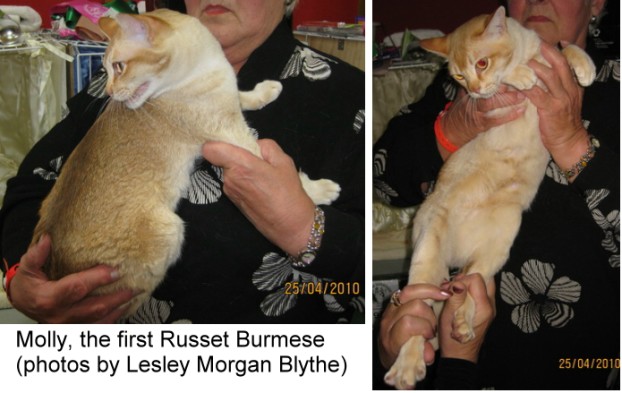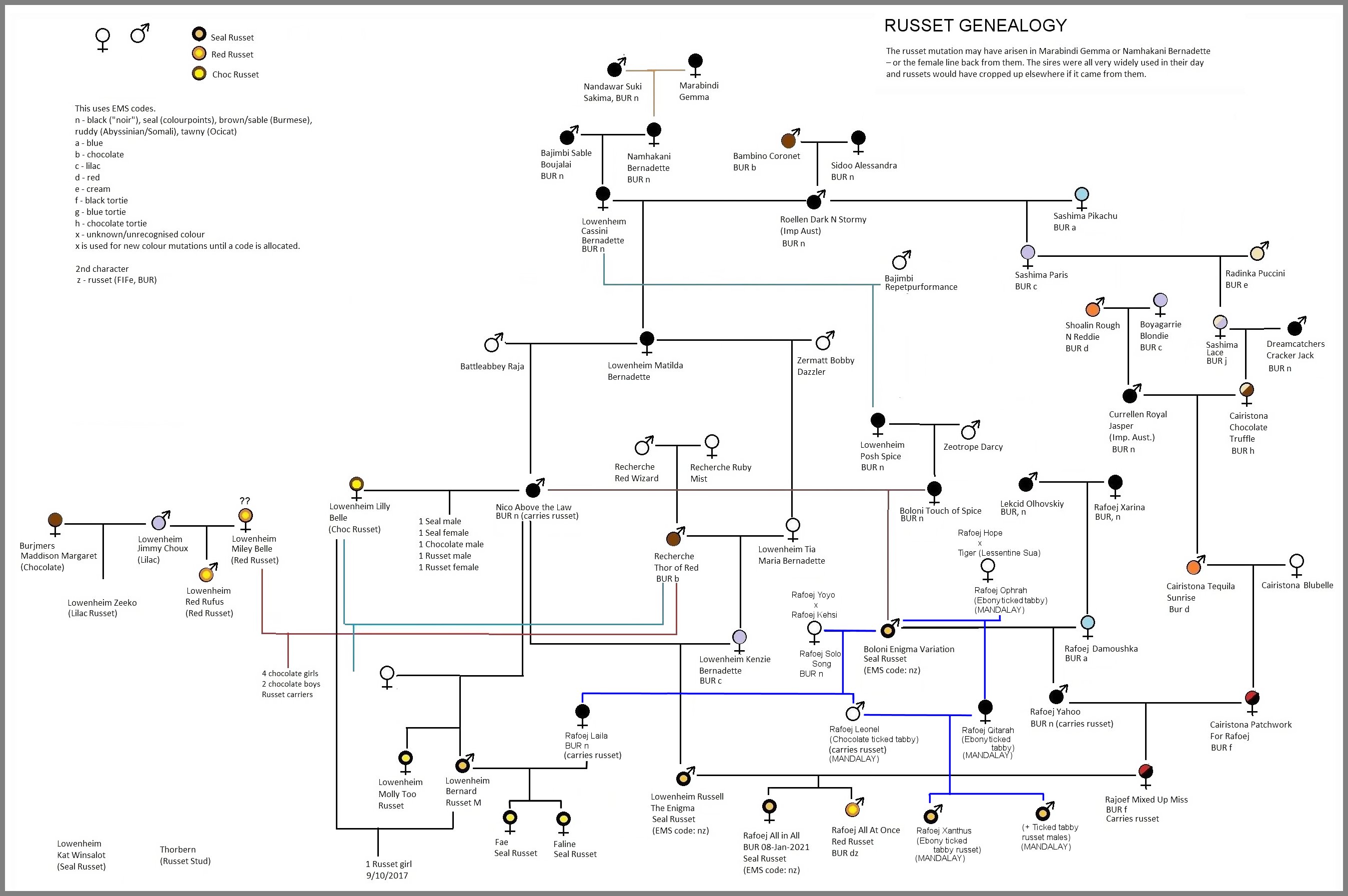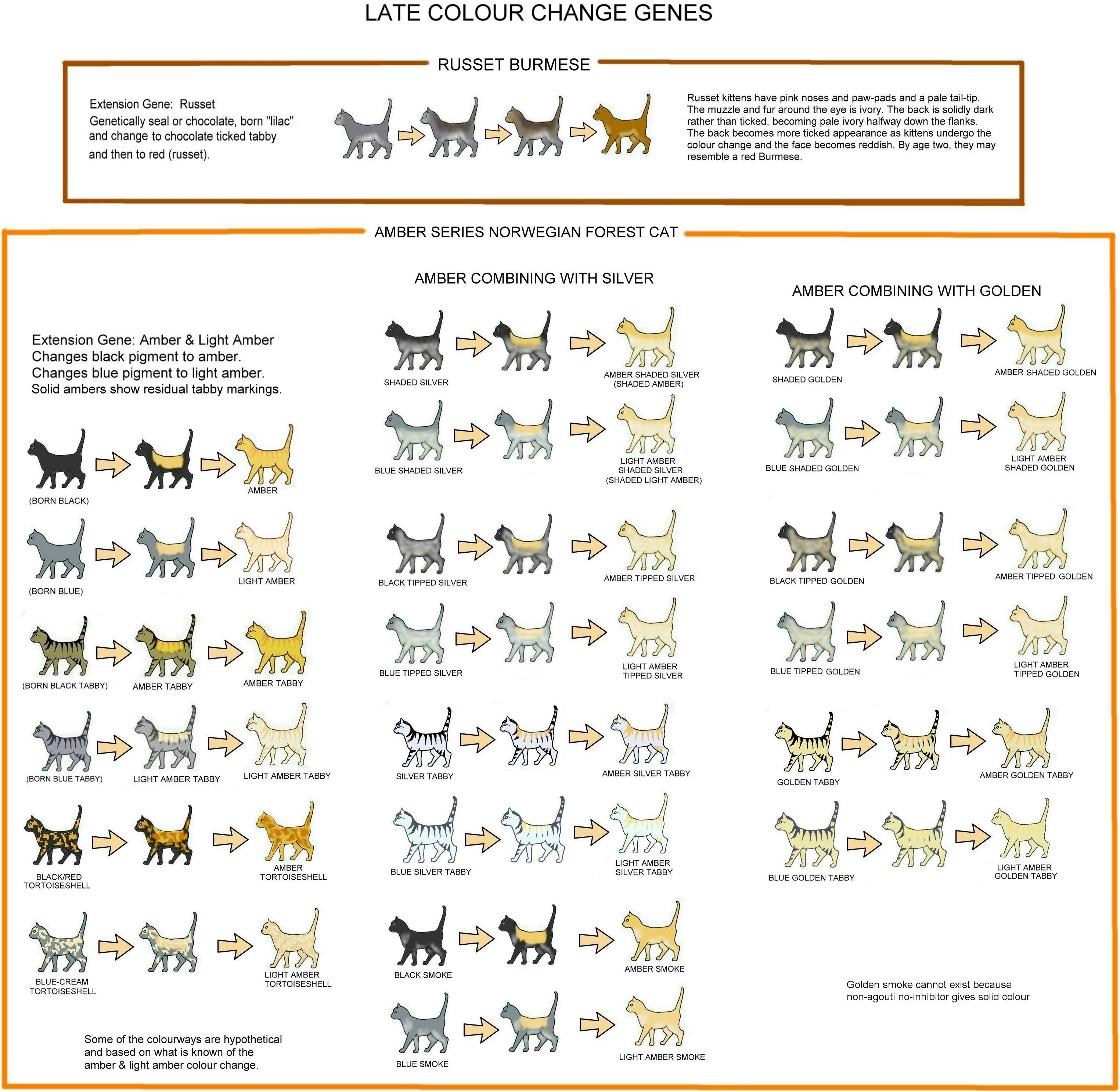
EXTENSION GENE: RUSSET - LATE COLOUR CHANGE GENES
The ancestors of the domestic cat were nondescript black/brown striped tabbies. Over the centuries, mutation produced a wide array of colours based on 2 different pigments. Eumelanin gives the blacks, browns and blues while phaeomelanin gives the reds, fawns and creams. A few other genes give further variations on those colours such silvers, colourpoints and solids/selfs. Mutations continue to occur and unexpected colours also turn up due to inbreeding where recessive genes, hidden for generations, start showing up.
Russet causes the coat colour to change from a black or blue colour to a reddish or golden colour as the cat matures. Russet replaces the birth colour. Kittens are not born russet. Russet can occur in solid or tabby-pattern cats.
RUSSET
Similar to amber is russet, which turned up in a line of seal (brown) European-style Burmese in New Zealand in 2007. It has subsequently been seen in the related Mandalay (similar to the Asian in Europe) and is a mutation of the extension gene. The first known russet was a pure-bred Burmese called "Molly Too" in 2007. There is now an experimental programme in NZ to breed Russet Burmese and to investigate dilute russet, russet tabby and solid russet (as opposed to the Burmese sepia form of russet).
The first russet kitten "Molly Too" (Lowenheim cattery, Bob and Nicky Mackenzie ) was born an "odd-coloured lilac (lavender)" which gradually lightened as she grew, progressing through lilac-caramel and chocolate ticked tabby and then dramatically changing to red. Chocolate ticked tabby and red were both impossible from her pedigree, and in any case, reds are not born as chocolate tabbies! Several more unusually coloured kittens were born in different litters and all went through the same colour/pattern changes. The ancestors of these kittens were seal Burmese and had no silver, tabby or Mandalay (Asian) blood. The pedigree had both dilute and chocolate, there were no reds, creams or torties until 4 generations back. DNA testing showed some kittens to be genetically seal and other genetically chocolate. Hence the new colour is due to a different mutation known as russet. Russet is due to a recessive mutation that causes black pigment (eumelanin) to gradually fade to a minimal amount while leaving red pigment (phaeomelanin) unaffected.

Russet kittens resemble tabbies at birth, but have pink noses and paw-pads, pale fur around the pads and genitalia and a pale tail-tip - all of which would be dark in tabbies. The muzzle and fur around the eye is ivory. The back is solidly dark rather than ticked, becoming pale ivory halfway down the flanks. The back becomes more ticked appearance, almost a saddle, as kittens undergo the colour change and the face becomes reddish. By age two, they may resemble a red Burmese. It differs from amber as ambers have dark noses and paw-pads. Non-agouti (solid) amber kittens are very dark with a dark face that is last to go red while russet kittens have off-white faces (possible due to Burmese sepia gene in the mix), which are the first part to go red (rather than the last as in ambers), and pale undersides. The russet colour change appears to be slower than the amber colour change. The birth colour of russets depends on whether they are genetically black, chocolate, cinnamon etc. One of the russet kittens bred by Bob and the late Nicky Mackenzie was born bright red instead of the dark, ticked-tabby-like colour pattern seen in most russets at birth. Russet kittens to date have been larger at birth than their siblings and somewhat on the large side as adults.

Rod Hitchmough (Rafoej cattery) has kindly provided most of this information on the russet colour in Burmese and Mandalay cats. Champion and Premier Boloni Enigma Variation (seal russet, bred by Bob and Nicki Mackenzie) was one of the first russet Burmese and went to Rod Hitchmough. "Enigma" sired several litters and helped work out the inheritance of russet. Rafoej Qitarah, an ebony ticked tabby daughter of Enigma Variation and Rafoej Ophrah, produced the first russet Mandalays; she also produced the first tabby russets when bred to Rafoej Leonel. Several of Enigma's mates and their russet descendants are shown on the genealogy on this page.
One of Engima's sons, Rafoej Leonel, sired an ebony ticked tabby russet Mandalay called Rafoej Xanthus. The russet gene has similar effects in Mandalays as in Burmese, and the same effect in tabbies as in genetically solid coloured cats. Xanthus is a lovely rich reddish tan colour, a colour subtly different from cinnamon or red tabby. A cinnamon russet Mandalay, Rafoej Red Hot, unfortunately escaped the cattery in 2021 and was never found.
MECHANISM OF THE RUSSET MUTATION
There are two different pigments in cats:
Eumelanin (the black based colours) and phaeomelanin (in "golden tabbies," rufism and red-based colours). Some out-dated texts refer to a third pigment called "trichochrome," but this is a component part of phaeomelanin, not a separate colour. All russet cats are genetically black. They have black skin, but a yellowish coat.
Variants in the melanocortin 1 receptor (MC1R), known as the extension (E) locus, interacts with the agouti locus to produce the eumelanin and pheomelanin (or trichochrome) pigments. Because the Burmese "russet" colour changes with aging, MC1R was suggested as candidate gene. The whole MC1R was directly sequenced in russet Burmese and suspected carriers and a mutation was identified. All russet coloured cats were homozygous for the mutation, and all carriers were heterozygous. The mutation was found in New Zealand cats and not in any cats from the USA. This MC1R variant defines a unique coloration is the second breed-specific MC1R variant identified in cats. It was given the genetic symbol "er." The interactions of the two recessive feline MC1R alleles (E > e, er ) is unknown.
Prior to the emergence of amber (in Norwegian Forest Cats in the early 1990s) there had never been any scientific evidence of a yellow recessive mutation (e) in the extension gene in cats. The Extension gene contributes to the Melanocortin 1 Receptor (MC1R) protein pathway. MCR1 is necessary for producing eumelanin. If the MCR1 receptor is damaged (mutation) it can't make eumelanin and makes phaeomelanin (yellow) instead. The Agouti allele also allows phaeomelanin production in black-based cats even if the MC1R receptor is undamaged; that's why agouti black-based cats have a yellowish background and dark markings while non-agouti black-based cats only produce eumelanin and are solid colour. Because of this, non-agouti russet (solid russet) can show a faint tabby pattern. The unmutated version of MC1R allows the black pigment to extend from the skin into the hair (hence "extension" gene). The mutated MC1R does not allow black pigment to extend into the hair, so the skin is black, but the hairs are reddish.
- GUSTAFSON N. A., GANDOLFI B. et LYONS L. A., (2017). Not another type of potato: MC1R and the russet coloration of Burmese cats. Animal Genetics., Vol(48), no.1, pp. 116-120..)
